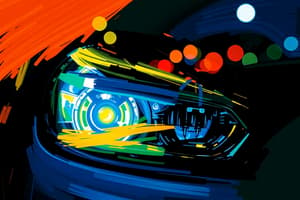Podcast
Questions and Answers
Why do you need to work especially hard to gather visual information in reduced visibility conditions?
Why do you need to work especially hard to gather visual information in reduced visibility conditions?
You need more time to respond to hazards.
How can you keep the inside of your vehicle windows clear after you have cleared them in high humidity or rainy conditions?
How can you keep the inside of your vehicle windows clear after you have cleared them in high humidity or rainy conditions?
Use the defroster or air conditioner.
How can you reduce glare and eyestrain when driving into sun glare from bright sunlight?
How can you reduce glare and eyestrain when driving into sun glare from bright sunlight?
Using sunglasses and the sun visor.
What should you do to give yourself more time for the IPDE Process at night?
What should you do to give yourself more time for the IPDE Process at night?
When driving at night with no other vehicles present, what headlights should you use?
When driving at night with no other vehicles present, what headlights should you use?
What should you do if an oncoming driver fails to use low-beam headlights after you switch to low-beam?
What should you do if an oncoming driver fails to use low-beam headlights after you switch to low-beam?
How can you attempt to reduce glare from an oncoming driver at night who fails to use low-beam headlights?
How can you attempt to reduce glare from an oncoming driver at night who fails to use low-beam headlights?
What happens when your headlights shine into fog?
What happens when your headlights shine into fog?
If you stop on the shoulder of the road in heavy fog, how should you warn other drivers that you are not moving?
If you stop on the shoulder of the road in heavy fog, how should you warn other drivers that you are not moving?
To help others see you during heavy rain, what should you use?
To help others see you during heavy rain, what should you use?
When driving in snow, what headlights should you use?
When driving in snow, what headlights should you use?
When does rain tend to make roadways the slickest?
When does rain tend to make roadways the slickest?
What occurs when your tires lose contact with the road?
What occurs when your tires lose contact with the road?
What should you do if you must drive through deep water?
What should you do if you must drive through deep water?
If windows ice up and traction conditions are especially hazardous, what might be best?
If windows ice up and traction conditions are especially hazardous, what might be best?
Why can a bridge surface freeze before adjoining road surfaces do?
Why can a bridge surface freeze before adjoining road surfaces do?
What is black ice?
What is black ice?
How can you identify you're in a front-wheel skid?
How can you identify you're in a front-wheel skid?
If the rear of your vehicle skids to the right, what should you do?
If the rear of your vehicle skids to the right, what should you do?
What is controlled braking?
What is controlled braking?
In all high-wind situations, what can be difficult?
In all high-wind situations, what can be difficult?
What could help cool the engine if the vehicle's temperature light comes on?
What could help cool the engine if the vehicle's temperature light comes on?
Why should you never remove a radiator cap on a hot engine?
Why should you never remove a radiator cap on a hot engine?
When driving in the winter, what should you make an extra effort to use?
When driving in the winter, what should you make an extra effort to use?
What could you experience if you have a leak in the vehicle's exhaust system?
What could you experience if you have a leak in the vehicle's exhaust system?
Flashcards are hidden until you start studying
Study Notes
Visibility & Hazard Response
- In reduced visibility, more effort is required to gather visual information, as responses to hazards take longer.
Maintaining Clear Windows
- In high humidity or rainy conditions, keep vehicle windows clear by using the defroster or air conditioner.
Sun Glare Management
- To reduce glare and eyestrain from bright sunlight, use sunglasses and the sun visor.
Night Driving Techniques
- To extend the IPDE (Identify, Predict, Decide, Execute) process at night, look beyond the headlight range.
- When no other vehicles are present at night, utilize high-beam headlights for better visibility.
Responding to Oncoming Traffic
- If an oncoming driver does not switch to low-beam headlights, slow down and glance at the right edge of the roadway to maintain orientation.
- Reduce glare from oncoming headlights by making quick glances ahead rather than staring directly into the light.
Fog and Visibility
- Headlights shining into fog reflect back light from water particles, reducing visibility.
- In heavy fog, to alert other drivers of your stationary position on the road, activate emergency flashers.
Rain and Driving Safety
- Use low-beam headlights in heavy rain to improve visibility.
- Roadways are slickest during the initial rainfall when water mixes with dirt and oils on the surface.
Hydroplaning
- Hydroplaning occurs when tires lose contact with the road, resulting in decreased control of the vehicle.
- If driving through deep water, apply light brake pressure to maintain control.
Winter Driving Precautions
- If windows ice up and traction becomes hazardous, it's advisable to avoid driving altogether.
- Bridge surfaces can freeze before adjacent roads due to cold air circulating above and below the surface.
Ice Awareness
- Black ice refers to thin, nearly invisible sheets of ice on the roadway.
- A front-wheel skid is identified when the vehicle tends to go straight despite steering input.
Skid Recovery Techniques
- If the rear of the vehicle skids to the right, counter-steering to the right helps regain control.
Braking Techniques
- Controlled braking involves manually applying brakes for efficient stopping.
High Wind Considerations
- Steering becomes more challenging in high-wind situations; maintain a firm grip on the wheel.
Engine Temperature Awareness
- If the vehicle's temperature light illuminates, turning off the air conditioner can assist in cooling the engine.
- Never remove a radiator cap from a hot engine to prevent scalding injuries from hot liquid.
Winter Driving Strategy
- Make a conscious effort to utilize the IPDE process when driving in winter conditions for enhanced safety.
Exhaust System Leaks
- A leak in the vehicle's exhaust system can lead to a dangerous buildup of carbon monoxide gas inside the cabin.
Studying That Suits You
Use AI to generate personalized quizzes and flashcards to suit your learning preferences.




